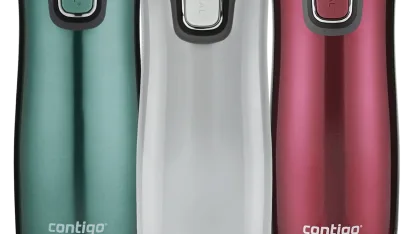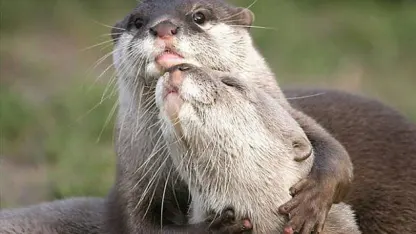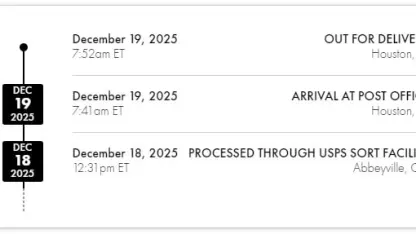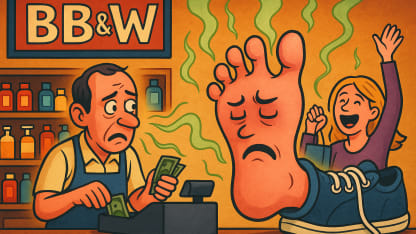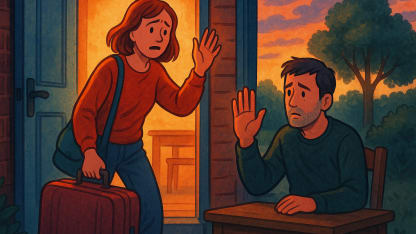Contigo 16oz West Loop 2.0









Our Take
- Keeps hot drinks hot, and cold drinks cold, like we wouldn’t have believed had we not seen it ourselves- The spill-fighting autoseal lid is a lot less hassle to clean than it was on v1.0- Fits in the typical car cupholder without cramming and squeezing- It’s really really good, and you know how much we hate positivity- Model: 70113, 70114, 70115 (we’ve grown to like these ZIP-code model numbers: a Google search turns into a little vacation when we find images like this, and this, and this - all from New Orleans)
The Thirsty Sound of Desert Rock
Hey, Meh writer @Jasontoon here. I’ve told you about this Contigo West Loop 16-ounce travel mug many times before. And you’ve told us about how insanely good it is at keeping hot drinks hot, or cold drinks cold, for hours, even under the most adverse conditions. Like in a sealed-up car on a sunny day. Or… a desert. And that gave me the idea for one of these weekend playlists I like to put together: desert rock.It’s the sound of searing heat and blinding light, of steady wheels on a blacktop and sunbaked mirages, of (as Midnight Oil’s breakthrough album put it) diesel and dust. The desert’s mixture of serenity and menace has enchanted artists of all kinds all over the world. In rock ‘n’ roll, it may have started with a couple of brothers from Brooklyn whose dad brought home a steel guitar from a hitch in the army in Oklahoma. With an uncle on drums, Santo & Johnny Farina hit the top of the charts in 1959 with the timeless, boundless “Sleepwalk”:https://d2b8wt72ktn9a2.cloudfront.net/mediocre/video/upload/v1735929087/no_longer_available_qknaul.mp4As the psychedelic revolution of the '60s spread to the remotest corners of the West, the wide open spaces of the desert carried a symbolic echo of the mind-expanding power of hallucinogens. In 1969, the Sir Douglas Quintet gave the Tex-Mex-influenced pop-rock of their earlier hits a psychedelic twist in “Mendocino”, “where life’s such a groove you blow your mind in the morning”:https://d2b8wt72ktn9a2.cloudfront.net/mediocre/video/upload/v1735929087/no_longer_available_qknaul.mp4These early desert-rock threads were woven, along with the psychedelic country I’ve talked about before, into the large and eventually lucrative country-rock story. But you’ve heard “Desperado” a million times, so I won’t go into all that here.It would take a crop of weird ‘80s bands - cleansed by the fires of punk, still in thrall to psychedelia, but anxious to explore - to create the first scene that anybody really called “desert rock.” These bands, from California and Arizona, had played quirky New Wave, revivalist Paisley Underground pop, or hardcore punk before discovering a new kind of inspiration in their arid surroundings.Green on Red started off doing bouncy psychedelic pop in the “Incense and Peppermints” vein, but soon wound up in the scorched hinterland you can hear on “Sea of Cortez”, from 1985:https://d2b8wt72ktn9a2.cloudfront.net/mediocre/video/upload/v1736541601/c4814aefb595666825da12a7fdcd1bf1.mp4Arizona’s Meat Puppets, on the other hand, were an obnoxious, screamy hardcore band before singer/guitarist Curt Kirkwood rediscovered his original guitar hero, ZZ Top’s Billy Gibbons. Kirkwood’s fast, fluid fingerpicking on “Swimming Ground” (also 1985) is as refreshing as the titular oasis: The most critically acclaimed band of this crop, Thin White Rope, used noisy guitars and metronomic Krautrock beats to build a menacing cloud of dust redolent of long straight highways to nowhere on songs like “Red Sun” (1988), complete with some twisted mariachi horns toward the end:https://d2b8wt72ktn9a2.cloudfront.net/mediocre/video/upload/v1736541439/1ede6dbde60cf0fc1f645606b2b7a42a.mp4When singer/songwriter Howe Gelb moved from Appalachian Pennsylvania to Tucson, Arizona in the early 1980s, he found his lonesome muse. Since then, his band Giant Sand has released dozens of albums, enjoyed the guest services of a long list of indie luminaries, and influenced generations of alt-country post-punks. 1986’s “Desperate Man” is an apt soundtrack for a cross-state flight from the authorities in a rusted pickup:https://d2b8wt72ktn9a2.cloudfront.net/mediocre/video/upload/v1736541447/517e2dbbca93f2fab4e697491a198c32.mp4Of course, the USA isn’t the only place with deserts, nor the only place people play rock ‘n’ roll. While American rock explorers were discovering our deserts, their Australian counterparts were discovering theirs. The multi-racial Warumpi Band were pioneers of Aboriginal pop, which included a healthy strain of Aussie country on songs like “Fitzroy Crossing” (1985 again - the year of desert rock, apparently):https://d2b8wt72ktn9a2.cloudfront.net/mediocre/video/upload/v1735929087/no_longer_available_qknaul.mp4Despite what you might think about Australia, Sydney isn’t exactly on the Outback’s doorstep. But those long distances didn’t keep Sydney’s biggest rock export, Midnight Oil, from discovering the seductions of the Aussie desert - and the troubles plaguing aboriginal communities, past and present, on a 1986 tour with the Warumpi Band. That experience inspired impassioned (and massively successful) pleas for justice like “The Dead Heart.” Here’s an MTV Unplugged version with digeridoo for added Outback atmosphere: https://d2b8wt72ktn9a2.cloudfront.net/mediocre/video/upload/v1735929087/no_longer_available_qknaul.mp4Meanwhile, in an entirely different desert on the other side of the world, a Tuareg refugee named Ibrahim Ag Alhabib was discovering the joys of the electric guitar. Ibrahim’s family, forced to flee Mali after a government crackdown in the 1960s, settled in Algeria, where he formed Tinariwen (“deserts”) in 1979. They created a stunning kind of Saharan rock that was the template for generations of bands to come - but under such trying circumstances, it took quite a while for the word to reach beyond North Africa. (Pitchfork has a great introduction to Sahara guitar music if you want to know more. Tinariwen’s “Chabiba” ("youth), released in 2009, captures the hazy, rolling sound Ibrahim created: https://d2b8wt72ktn9a2.cloudfront.net/mediocre/video/upload/v1735929087/no_longer_available_qknaul.mp4Back in the states, a group of freaks in the California desert was keeping the desert-psychedelia flame alive by dragging their amps into the wilderness for all-night jams under the stars. Yawning Man formed in 1986 but didn’t release any recordings until 2005. Among the goggle-eyed attendees were Josh Homme (who later formed Queens of the Stone Age) and Brant Bjork (the founder of Kyuss). By the time the first official Yawning Man album emerged in 2005, they still hadn’t been surpassed by the stoner rock giants they’d inspired. The title track, “Rock Formations”, proves it:https://d2b8wt72ktn9a2.cloudfront.net/mediocre/video/upload/v1736541459/fa7649c6ad44e9185c76010e1bbcaab2.mp4In the early 2000s, a loose group of luminaries of that “Palm Desert scene”, including members of Yawning Man, Kyuss, and QOTSA, recorded a couple of albums as Orquesta del Desierto. Here’s the atmospheric “Summer” (2004):https://d2b8wt72ktn9a2.cloudfront.net/mediocre/video/upload/v1735929087/no_longer_available_qknaul.mp4There isn’t really a distinct scene or a defined sound called “desert rock”. But anywhere hot and dry, where kids pick up guitars and maybe ingest some psychoactive substances, will throw up a few freaks who try to recreate that desert feel in sound. Strange Lot are a Tucson band tripping toward their own flavor of Sonoran psych on their 2015 debut album Another Mind. If you like “Supremium”, buy the record on Bandcamp:https://d2b8wt72ktn9a2.cloudfront.net/mediocre/video/upload/v1736541476/0c4fa1dcd09d415191eba694f00402db.mp4Let’s put this post to bed with a lullaby that inspired the Meat Puppets’ Curt Kirkwood, and doubtless many others, to explore the vast, arid stretches of desert rock. If all you know of ZZ Top is “Sharp-Dressed Man”, you’ll be surprised by the delicate, evocative 1976 instrumental “Asleep in the Desert”, a fitting bookend to “Sleepwalk”:https://d2b8wt72ktn9a2.cloudfront.net/mediocre/video/upload/v1736541484/118f75430cf94a3b624d7699a2aefe1b.mp4Until my next weekend playlist, stay thirsty. And stay hydrated, maybe with the Contigo West Loop 16-ounce travel mug.Our previous weekend playlists for your next desert trek:- Laminates & Lamentations: 10 Songs About Touring- 14 Basslines You Should Hear on a Decent Speaker- Sweat Bands: The '80s Gym Rock Challenge- Grazing in the Grass: A Picnic Playlist- Turn On Country Style: Psychedelic Country Nuggets- Library Music: Overdue for Recognition- Beyond the Legend: Bob Marley Deep Cuts- Songs to Scrub By: Our Shower Playlist- Gated Reverb: Boom and Bust- 808 101: The Drum Machine That Moved The '80s

